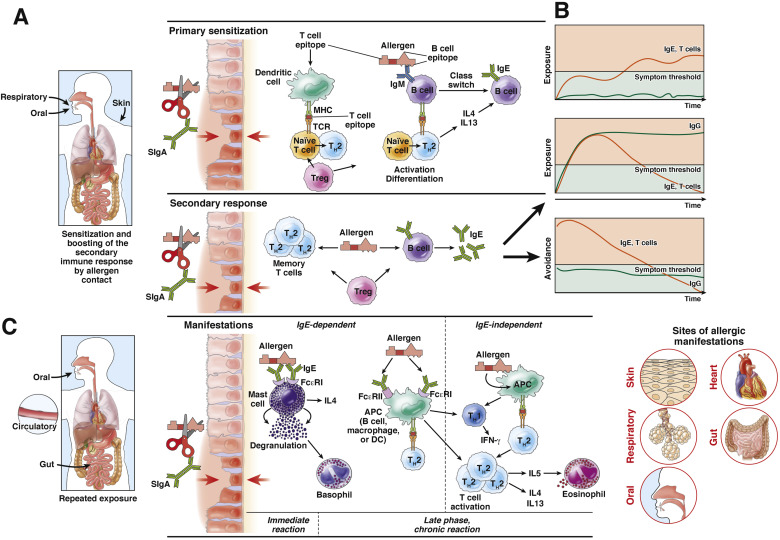Food allergy (food hypersensitivity) is an abnormal reaction of the body’s immune system caused by food. More precisely, it is an allergic reaction caused by allergens in food.
Food allergy has become a global public health problem. According to reports, the incidence of allergic reactions in adults is about 3% to 4%, and the incidence in children is as high as 6%. At present, there are more than 180 types of allergic foods identified. According to the UN Food and Agriculture Organization’s report, more than 90% of food allergens are found in milk, eggs, fish, crustacean aquatic products, peanuts, soybeans, nuts and wheat. Food allergic reactions are very harmful to the body, which can affect the respiratory system, gastrointestinal system, central nervous system, skin, muscles and bones, etc., and may even cause anaphylactic shock and endanger life. At present, allergy research focuses on the sensitization detection of food allergens. In view of the different sensitivity of each individual’s immune response to allergens, the sensitization evaluation of food allergens is of great significance.

The material basis of food allergies includes food allergens and specific IgE. According to different evaluation objects, the sensitization evaluation methods of food allergens are divided into two categories: serological methods and cytological methods. The serological method is mainly to evaluate the sensitization of the protein according to the binding capacity of IgE in the positive serum. The cytological method evaluates the sensitization of immune cells based on the protein stimulated to produce inflammatory mediators. According to the different places where the evaluation method is performed, it can be divided into in vivo method, in vitro method and bioinformatics comparison method. This article focuses on methods for evaluating the sensitization of food allergens in the body.
The in vivo method uses a very small amount of food allergens to stimulate the body, and then evaluates the sensitization of food allergens based on whether the body has symptoms of allergic reactions or detecting the level of IgE in the body. It mainly includes double-blind placebo-controlled food challenge experiment (DBPCFC), skin experiment (ST) and animal models.
Double-blind Placebo-Controlled Food Challenge Experiment
The double-blind placebo-controlled food challenge experiment (DBPCFC) uses suspicious food to stimulate the patient, and then determines whether the food is allergenic according to the patient’s symptoms. This method is considered to be the gold standard for diagnosing food allergies, and it can also be used to determine the threshold of allergenic foods. In the absence of an allergic reaction, it is not sufficient to determine an exclusion diet based on the results of IgE detection by serological methods, and the use of DBPCFC to determine food allergens can effectively stop most children’s unnecessary diet exclusion. DBPCFC generally needs to be carried out in a hospital or outpatient department. It requires medical staff and equipment capable of dealing with severe allergic reactions, and the operation and testing by experienced nursing staff. The most important thing in the experiment is to control double-blind, experimental dose and placebo. Double-blind control requires that the difference between the tested food and the placebo be eliminated as much as possible, that is, the intermedium can mask the taste, texture and odor of the tested food, which limits the experimental dose, but can minimize the subject’s subjective factors to the experiment The impact of results. For most foods, patients, and clinical conditions, it is appropriate to use 3, 10, 30, 100, 300, 1,000, and 3,000 mg of challenge agents every 20 minutes. For liquid and pasty foods, the dosage cannot exceed 250 mL; for solid foods, the dosage cannot exceed 125 g.
Skin Test
The skin test is an immunological test by means of the reaction of antigens and antibodies in or on the skin. There are two types of skin tests, one is the skin prick test (SPT) and the other is the intradermal test (IDST). The sensitivity of SPT is highly consistent with the clinical results, and the specificity is good, but it is not as sensitive as the intradermal experiment. SPT generally selects healthy and complete skin on the inside of the forearm or on the back. Studies have shown that the back is more suitable for SPT than the inside of the forearm. Not all patients are suitable for SPT, such as those with severe urticaria.
Animal model
The goal of this method is to provide a model that can provide useful and reliable information when combined with other relevant data to help make a reasonable evaluation. However, there is no animal that can meet all the requirements of an ideal animal model. Commonly used animal models are rats, dogs, and pigs. When selecting, it is necessary to clarify the operating characteristics, limitations, and reliability in different environments. Commonly used mouse species are BALB/c inbred mice and brown Norwegian mice. The advantages of the mouse model are its small size, short reproduction cycle, similar to human immune mechanism, and rich related immunological information; its disadvantage is that allergic reactions are complex, and it is difficult to find reliable reaction markers to reflect the potential sensitization of the protein. Therefore, it is necessary to detect related serological indicators.
